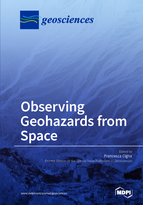Observing Geohazards from Space
A special issue of Geosciences (ISSN 2076-3263). This special issue belongs to the section "Natural Hazards".
Deadline for manuscript submissions: closed (30 June 2017) | Viewed by 92384
Special Issue Editor
Interests: landscape evolution; geophysical hazards; archaeology; cultural heritage; remote sensing; earth observation; InSAR; landslides; land subsidence; ground instability
Special Issues, Collections and Topics in MDPI journals
Special Issue Information
Dear Colleagues,
The goal of this Special Issue of Geosciences is to gather high-quality original research articles and reviews on the use of Earth Observation (EO) data and technologies to image and monitor geohazards from space.
Geohazards, such as landslides, volcanoes, earthquakes, tsunamis, ground subsidence and heave, pose significant risks to human life and property. Even when not with catastrophic consequences, or when characterised by relatively slow onset and evolution, these processes may be damaging over long time periods. Human interaction with the environment may also combine with natural processes, and thus trigger, induce acceleration or exacerbate the impacts of geohazards on built environment.
With a wide spectrum of imaging capabilities—from optical to radar sensors, low to very high resolution, continental to local scale, single-image to multi-temporal approaches, yearly to sub-daily acquisition repeat cycles—nowadays, EO offers several opportunities for the geoscience community to map and monitor geohazards from space.
Topics of interest of this Special Issue include, but are not limited to: development, validation and implementation of satellite EO data processing methods and applications for geohazards mapping and monitoring; radar interferometry (InSAR), object-based image analysis (OBIA), multi-spectral data analysis, feature extraction, time series analysis, photo-interpretation, and digital fieldwork.
Authors are encouraged to approach the Guest Editor by sending a short abstract outlining the purpose of the research and the principal results obtained, in order to verify at an early stage if the contribution they intend to submit fits with the objectives of the Special Issue.
Dr. Francesca Cigna
Guest Editor
Manuscript Submission Information
Manuscripts should be submitted online at www.mdpi.com by registering and logging in to this website. Once you are registered, click here to go to the submission form. Manuscripts can be submitted until the deadline. All submissions that pass pre-check are peer-reviewed. Accepted papers will be published continuously in the journal (as soon as accepted) and will be listed together on the special issue website. Research articles, review articles as well as short communications are invited. For planned papers, a title and short abstract (about 100 words) can be sent to the Editorial Office for announcement on this website.
Submitted manuscripts should not have been published previously, nor be under consideration for publication elsewhere (except conference proceedings papers). All manuscripts are thoroughly refereed through a single-blind peer-review process. A guide for authors and other relevant information for submission of manuscripts is available on the Instructions for Authors page. Geosciences is an international peer-reviewed open access monthly journal published by MDPI.
Please visit the Instructions for Authors page before submitting a manuscript. The Article Processing Charge (APC) for publication in this open access journal is 1800 CHF (Swiss Francs). Submitted papers should be well formatted and use good English. Authors may use MDPI's English editing service prior to publication or during author revisions.
Keywords
- Geohazards
- Natural Hazards
- Geological Processes
- Emergency Response
- Damage Assessment
- Slope Instability
- Volcanoes
- Earthquakes
- Floods and Tsunamis
- Land Subsidence and Heave
- Earth Observation
- Radar, InSAR
- Multispectral
- Object-Based Classification
- Digital Fieldwork






